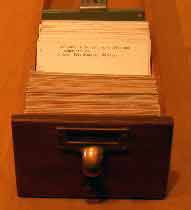 Everybody knows what a card is but some among us don’t know what a card catalog is (like my daughter Stella, 15, who looked at me blankly when I said the words.) It’s no wonder, the book inventory and tracking system — wood drawers with their hand-typed cards listing the title, author and catalog number of the book — was made obsolete in the 1980s and 1990s with the advent of online catalogs which do the job with the clickety clack of a keyboard instead of the quiet flipping through the yellowing cards with their smudges from human touch and pencil marks from librarians.
Everybody knows what a card is but some among us don’t know what a card catalog is (like my daughter Stella, 15, who looked at me blankly when I said the words.) It’s no wonder, the book inventory and tracking system — wood drawers with their hand-typed cards listing the title, author and catalog number of the book — was made obsolete in the 1980s and 1990s with the advent of online catalogs which do the job with the clickety clack of a keyboard instead of the quiet flipping through the yellowing cards with their smudges from human touch and pencil marks from librarians.
Enter David Bunn, an artist whose singular calling for the last ten or more years has been to mine the card catalog of the Los Angeles Central Library as the basis for his art. Bunn has an exhibit, “Double Monster,” at Temple Gallery Old City right now and it’s a trip down memory lane for those who remember card catalogs. And for those who don’t it’s an installation that evokes library and archive that includes some trippy moments. (image is card catalog drawer and cards included in the exhibit. Happily, a viewer can flip through the cards and get an understanding of how the now-obsolete system works)
Bunn, was given the entire card catalog of the LA Library in 1993 after he made a public art project with them at the Central Library (he used the old cards to paper the interior of the library’s elevators and elevator shafts).
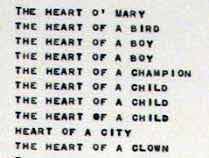
Like a lot of artists who are pack rats Bunn has turned his gift horse into golden opportunities — making art that riffs on words, on books, on archives and on human thought. In this project (I’m not sure he’s done exactly the same in others) he has taken book titles and turned them into poems. The poems — highly repetetive and rhythmic — are of deeply beat weirdness or weird beatness. I think they’re pretty mesmerizing. Typed in capital letters in sans serif type, they are lists that seem chants and dirges. And they have a physical presence that evokes detection and a mind at work to figure something out. (image is detail from a poem included in the exhibit. The poem, like all Bunn’s poems, is made of book titles from the LA Library card catalog.)
“Double Monster” is a particularly Philadelphia project. In it Bunn intertwines the LA card catalog with that of the Philadelphia Mutter Museum of the College of Physicians. The interlacing is driven by the Mutter’s cards which are not there in the flesh (or paper as it were) but represented by trompe l’oeil drawings by Madena Asbell, who, I’m told by Temple Gallery Director Sheryl Conkelton, was trained as a medical illustrator. Asbell’s drawings of the Mutter cards are double-take moments — their realism is convincing and a bit creepy.
Bunn’s poems use the words from the medical specimen cards as search engines to turn up book titles with the same words. (see poem above…which matches the term “the heart” from a Mutter specimen card with the book titles from the library.)
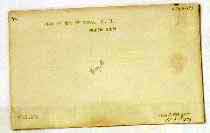
The faux Mutter cards, (shown left is one example) refer, of course, not to books but to medical specimens housed in the Mutter Museum. So, in the case of the exhibit’s title card, “Double Monster,” the listing describes the specimen and gives the date it entered the collection and the name of the donors. The Mutter cards are more mysterious than the book cards, and evoke a level of whodunit totally appropriate to the institution. Double Monster’s card, for example, has the word “missing” hand-written on it. When did the specimen go missing? Was it ever found? This is not a book we’re talking about and thus the thought of a missing, double-headed early foetus, sends the mind racing.
Bunn, a Los Angeles artist, got his Philadelphia connection in 1998 when artist and curator Andrea Packard, director of Swarthmore’s List Gallery featured his work in an exhibit. During that time Bunn toured the Mutter Museum and met Gretchen Worden who invited him to do a project. “Double Monster” completed in 2000 is the result, and this is its Philadelphia debut although it’s been shown elsewhere (New York, for example).
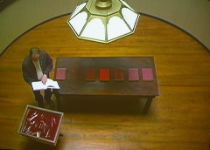
Bunn made a video of himself reading his poems from the Clinical Amphitheater at Pennsylvania Hospital, the city’s oldest hospital, established by Ben Franklin. (image) The fifteen-minute video, “Needles and Pins” is projected in the dark video closet in the gallery.
The birds’ eye view of the artist, a tray of surgical tools nearby, reading the repetetive words under the elegant Tiffany-esque light recalls the two great paintings by Thomas Eakins, The Gross Clinic and The Agnew Clinic, both set in a medical amphitheater where doctors were performing a surgery before an audience of students.
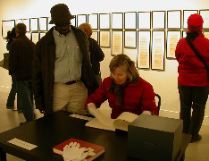
The installation at Temple, includes a reading table with books compiling the cards in the show. For the twenty minutes or so that I was in the gallery, there was a steady stream of people sitting, putting on the white gloves, and pouring through the books. This homey, interactive element, evocative of times long gone when libraries were more a part of everybody’s lives, takes the installation to a public level that feels right for a show that blends books from a public collection with human specimens from one of the city’s most beloved public museums.
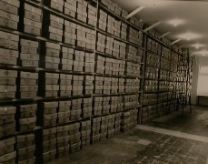
Finally, when you go, don’t miss the two pendant photographs of the boxes housing the card catalogs the show is based on. The photograph of the artist’s studio (right) shows theLA Public Library card catalog boxes looking a lot like the Titanic, looming in the space stacked to the ceiling. The idea of all the books represented in those boxes is a shiver moment and an homage to human thought and aspirations. (image below is photo of the Mutter Museum’s card catalog stored in the basement of the museum.)
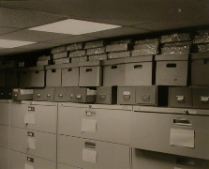
The exhibit is dedicated to the memory of Gretchen Worden, Mutter Museum director from 1988-2004 who was a graduate of Temple in anthropology (1970) and who died earlier this year.









